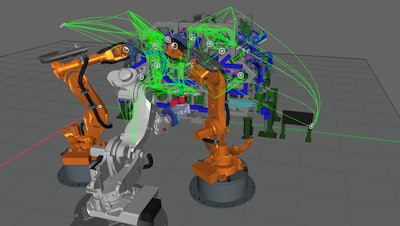Realtime Robotics is a Boston-based startup founded in 2016 that wants the manufacturing industry to rethink robotics. The company specializes in path planning software that uses artificial intelligence to optimize industrial robot paths in real-time. The company is automating integration.
At Automate 2025 in Detroit, Michigan, Ville Lehtonen, vice president of product at Realtime Robotics, discussed some of the early adopters in the manufacturing industry who are using the company’s cloud-based Resolver platform to build a better path, even outperforming human counterparts by up to 20%.
Typically, simulation engineers or integrators use various simulation tools to optimize workcells, getting robots to work together. The process can be lengthy and costly.
Lehtonen said Resolver “solves” modern workcells in hours. Previously, these applications would take hundreds of hours of human labor.
In one example, he noted a welding application that had more than 20 robots working in close proximity to one another. Resolver created a path that sped up the workcell, taking the cycle time from 41.47 seconds down to 32.04 seconds.
The program created a collision-free path while taking safety interlocks— safety components that prevent a device from operating unless certain conditions are met—into account.
The path-optimizing capabilities are possible due to the enormous compute capacity in the cloud, which dramatically speeds everything compared to running a simulation tool locally on a laptop. AI can also learn, so it can “solve” for various scenarios and optimize processes over time.
 Path planning software from Realtime Robotics uses artificial intelligence to optimize industrial robot movements in real-time.Realtime Robotics
Path planning software from Realtime Robotics uses artificial intelligence to optimize industrial robot movements in real-time.Realtime Robotics
Potentially Drastic Changes for Integrators
Right now, even top-tier manufacturers rely on integrators to build paths for new workcells. Lehtonen, who has had conversations with Tier 1 automotive and glass manufacturers, as well as some government agencies heavily staked in R&D, said integrators, particularly those in high mix, low volume applications, companies with more than 50 switchovers, must adapt and learn to embrace AI. For example, he said we’re not far from a single production line that can switch from making cruise missiles to torpedoes with a click of a button. But first, it will take a shift in mindset.
“It’s about getting manufacturers to think big again,” Lehtonen said. “The industry is selling very few robots and still not keeping up with demand.” He says there are about 270 robots for every 10,000 manufacturing workers, and most are at auto manufacturers.
“Why aren’t we doing everything with robots?” he asked. “Because setting them up is a pain.”
A recent report from the International Federation of Robotics (IFR) registered 381,964 industrial robots in use on U.S. factory floors in 2023, about a 10% increase from 2022. The report says annual installations reached 37,587 units in 2023. Even though it was a decrease of 5%, it was still the third-best result in U.S. history.
“We need to democratize robotics,” Lehtonen said. “We should be selling 50 million robots instead of 50,000 … We need more big picture thinking.” He says U.S. manufacturing has, in a way, become complacent, particularly when compared to China’s grand visions for its manufacturing future. Even Thailand has grand visions, erecting entire cities built to be hubs of advanced manufacturing.
Lehtonen said it’s time to reimagine modern manufacturing with a Silicon Valley hustle and ambition.
In Case You Missed It: Highlights from Automate 2025
Inbolt: Giving Robots Better Eyes
Inbolt co-founder Albane Dersy wants to drastically lower the cost of automation by giving robots the power to see, making vision guidance easy with real-time part mobilization. For example, if a robot was laying a bead of adhesive on a part and the part moved, the robot can adjust on the fly and follow the path. The technology will help manufacturers move beyond rigid stations, cut engineering time with faster programming and reduce the amount of time it takes lines to get up and running.
Dirac: Automated Work Instructions
Dirac created BuildOS, a new tool for manufacturing engineers that “automates the grunt work” with digital work instructions—step-by-step guidance for machine operators directly at the point of work. These are model-based animations, annotated photographs, how-to videos and interactive 3D models that help “upgrade less-skilled operators.” This is a real solution to the industry’s tribal knowledge problem.
Olis Robotics: Ring Camera for Industrial Automation, Robots
Olis Robotics wants to make your mobile device a gateway to remotely managing an automation cell by directly connecting it to an industrial controller. Olis created an app that synchronizes real-time video with system logs, providing a complete picture of what went wrong so engineers can remotely troubleshoot problems and keep production running. Olis CEO Fredrik Ryden said it works just like “a ring camera for industrial automation and robots.” Full set-up takes less than five minutes, even when retrofitting legacy automation systems.


